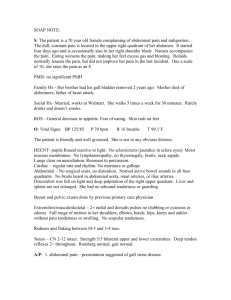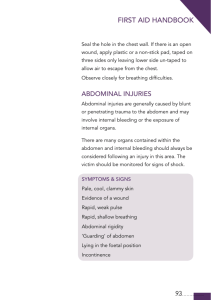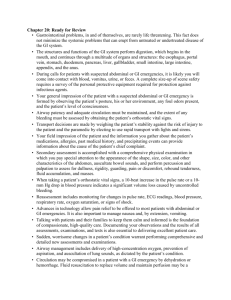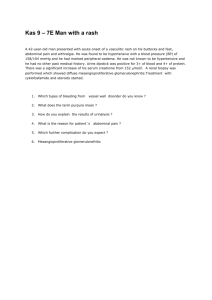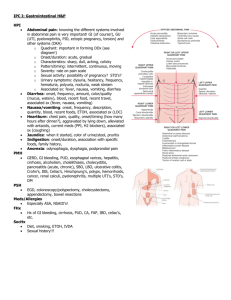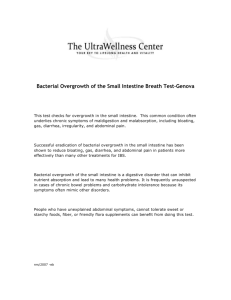Acute Abdominal Emergencies
advertisement
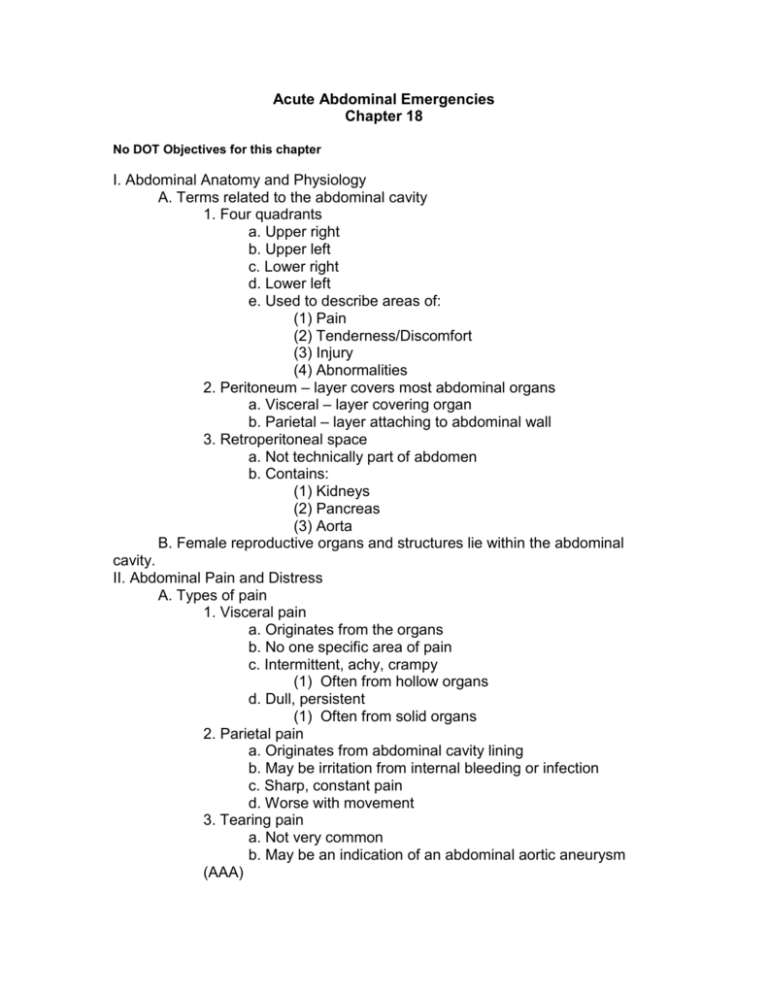
Acute Abdominal Emergencies Chapter 18 No DOT Objectives for this chapter I. Abdominal Anatomy and Physiology A. Terms related to the abdominal cavity 1. Four quadrants a. Upper right b. Upper left c. Lower right d. Lower left e. Used to describe areas of: (1) Pain (2) Tenderness/Discomfort (3) Injury (4) Abnormalities 2. Peritoneum – layer covers most abdominal organs a. Visceral – layer covering organ b. Parietal – layer attaching to abdominal wall 3. Retroperitoneal space a. Not technically part of abdomen b. Contains: (1) Kidneys (2) Pancreas (3) Aorta B. Female reproductive organs and structures lie within the abdominal cavity. II. Abdominal Pain and Distress A. Types of pain 1. Visceral pain a. Originates from the organs b. No one specific area of pain c. Intermittent, achy, crampy (1) Often from hollow organs d. Dull, persistent (1) Often from solid organs 2. Parietal pain a. Originates from abdominal cavity lining b. May be irritation from internal bleeding or infection c. Sharp, constant pain d. Worse with movement 3. Tearing pain a. Not very common b. May be an indication of an abdominal aortic aneurysm (AAA) 4. Referred pain a. Pain felt in area different than where it originates b. Caused by shared nervous pathways 5. Epigastric Pain Considerations a. Pain from an MI may be felt as abdominal discomfort b. Patients may describe this pain as indigestion B. Assessment and care of abdominal distress 1. Assessment a. Determine level of consciousness. b. ABCs c. Determine if signs of shock are present. d. SAMPLE History (1) Symptoms—evaluate the patient’s pain and discomfort (OPQRST). (a) Onset (b) Provocation/palliation (c) Quality (d) Region/radiation (e) Severity (f) Time (2) Allergies (3) Medications (4) Pertinent past history (5) Last oral intake (6) Events leading to the emergency e. History information specific to female patients (1) Where are you in your menstrual cycle? (2) Is your period late? (3) Do you have bleeding from the vagina now that is not menstrual bleeding? (4) If you are menstruating is the flow normal? (5) Have you had this pain before? (When did it happen and is this pain similar?) f. Geriatric patients (1) Decreased ability to perceive pain (2) Many older patients are on medication that controls heart rate, and the pulse may not become rapid to compensate for blood loss. g. Physical examination (1) Inspection (a) Bloating (b) Distention (c) Discoloration (d) Abnormal protrusions (2) Palpitation (a) Do each quadrant separately. (The quadrant with the area of the pain should be done last.) (b) Guarding i. Protective defensive to prevent pain ii. Arms drawn across abdomen iii. Abdominal muscle clenching (c) Masses i. Pulsating may indicate aneurysm h. Vital signs (1) Abdominal pain may mask other serious conditions (2) Take every 5 minutes. 2. Abdominal conditions by quadrant a. Right upper quadrant (1) Liver (2) Right kidney (3) Gallbladder (4) Pancreas (5) Small and Large intestine (6) Aorta b. Left upper quadrant (1) Liver (2) Spleen (3) Left kidney (4) Stomach (5) Pancreas (6) Small and Large intestine (7) Aorta c. Right lower quadrant (1) Right kidney (2) Colon (3) Small and Large intestine (4) Ureter (5) Appendix (6) Bladder d. Left lower quadrant (1) Left kidney (2) Colon (3) Small and Large intestine (4) Ureter (5) Bladder 3. Abdominal conditions a. Appendicitis (1) Rebound Tenderness over RLQ usually b. Cholecystitis (1) RUQ or Sharp Epigastric Pain (2) Female, 40, Fair, Fried Foods c. Pancreatitis (1) Epigastric Pain (2) Chronic Alcoholics, very serious d. Ulcer/internal bleeding (1) Complaint of coffee-ground emesis or dark tarry stools e. Abdominal aortic aneurysm (AAA) (1) Pulsatile Mass, tearing pain f. Hernia (1) Part of intestine through abdominal wall or groin g. Renal colic (1) Flank Pain, very painful 4. Patient care a. Treat ABCs. b. Administer oxygen (10–15 lpm by nonrebreather mask.) c. Place patient in a position of comfort. (If airway problems and/or shock are present then the priority is to try to position the patient appropriately to treat these conditions.) d. Transport prompt
